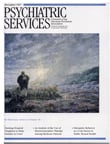In 1928 Freud published an essay about the pathological gambling of Fyodor Dostoyevsky, the Russian author who wrote a novel called The Gambler based on his personal experience. However, not until 1980 was pathological gambling acknowledged by the American Psychiatric Association as a psychiatric disorder of impulse control.
The classification of pathological gambling as a psychiatric disorder was followed by the development of uniform diagnostic criteria, a valid, reliable screening tool—the South Oaks Gambling Screen (SOGS) (
1)—and preliminary neurobiological studies that implicated serotonergic dysfunction in pathological gambling (
2). However, few psychiatrists have had substantial experience in the prevention, assessment, and treatment of pathological gambling. Moreover, despite rapid increases in gambling opportunities in the last decade, public health, clinical, and social implications of gambling behavior have been understudied, particularly among adolescents.
We would like to argue that the current lack of knowledge about and failure to respond to adolescent gambling behavior is similar to the situation that existed 30 years ago in the area of another addiction, substance abuse. We fear that failure to draw attention to the needs of adolescents at high risk for problem and pathological gambling may result in an increase in the number of pathological gamblers in the next generation. Such an increase would be accompanied by emotional and financial damage to these individuals and their families and by legal and financial costs to the community.
Description and definitions
Gambling is a popular recreational outlet for youth and may include sports betting, cards, lotteries, animal racing, and casino gambling. As the popularity of legalized gambling grows, a disturbing report suggests that gambling by teenagers in casinos is on the rise, and that enforcement of legal age restrictions at casinos is quite poor (
3). As with psychoactive sub stance use, the threshold that separates normative from pathological behavior, particularly in youth, is not clear (
4). Whether problematic gambling is an early stage of pathological gambling is not entirely clear. It has been consistently found that rates of problem gambling among adolescents are higher than in the adult population, and that only a subgroup of adolescents may be vulnerable to developing future problem gambling and pathological gambling (
5).
Shaffer and Hall (
6) investigated nosological differences in gambling behavior that affect the interpretation of epidemiological studies of adolescents. They examined the findings of nine North American studies that included 7,700 adolescents and that used different definitions of adolescent gambling behavior and various methods for data gathering. They concluded that a three-level scale of gambling behavior severity is useful for adolescents. Level 1 reflects nonproblem social gambling and accounts for between 79 and 83 percent of adolescents with gambling behavior. Level 2, defined as at-risk or in-transition gambling, represents a subclinical but meaningful level of involvement in gambling and symptoms of problem gambling. This level accounts for between 9.9 and 14.2 percent of adolescents with gambling behavior. Level 3 indicates serious problem gambling or pathological gambling and accounts for 4.4 to 7.4 percent of adolescents with gambling behavior.
However, little is known about whether the signs and symptoms of pathological gambling among adults, as defined in
DSM-IV, by Gamblers Anonymous, and by the SOGS (
1), are relevant to adolescents. If they are, we do not know to what degree and how to validly measure these symptoms.
Correlates of gambling behavior
There are reasons to be concerned about the current prevalence of gambling, particularly among youths and their families. Gambling behavior begins during childhood and adolescence. Correlates of problem gambling include poor academic achievement, truancy, being a male, regular drug use, delinquency, progression to further problematic gambling behavior, and problematic parental gambling. (
5). Other studies have found that teenagers involved in problem or pathological gambling are more likely to be involved in aggressive behavior, stealing, school truancy, drug sales, and prostitution (
7,
8). More than 13 percent of the adolescents in one study who reported gambling felt guilty about their gambling (
5). Almost 4 percent of high school students already have sought help for their gambling (
6).
An increased incidence of alcoholism, substance use disorders, comorbid psychiatric disorders, suicidal behavior, and gambling-related problems has been found among pathological gamblers and their family members (
9,
10). For a substance abuser enrolled in treatment, problematic gambling may accompany and reinforce continued drug dependence, interfere with treatment engagement, and be a factor in relapse (
11).
What to do
Unfortunately, child and adolescent gambling behavior has received limited social, clinical, and empirical attention. Efforts to address gambling behavior among minors are still in their infancy (
12,
13). Failure to draw attention to the needs of this subpopulation of adolescents at high risk for problem and pathological gambling may result in growing numbers of pathological gamblers in the next decade.
A systematic effort should be launched into the epidemiological and clinical assessment, prevention, and treatment of adolescent gambling behavior in community samples and among youths with substance use disorders and other psychiatric disorders who are at high risk for or have already developed problem or pathological gambling. More specifically, the following issues should be addressed.
•Empirical definition and measurement of gambling behavior among adolescents
•Elucidation of the mechanisms of initiation, transition between levels, and maintenance of gambling behavior in this population
•Determination of the prevalence of gambling behavior among adolescents and its correlation with specific psychiatric disorders such as conduct, major depressive, anxiety, and substance use disorders
•Examination of the association between gender, race or ethnicity, parental history of problematic or pathological gambling, and sociodemographic variables and the different levels of adolescent gambling
•Exploration of the chronological relationship between gambling behavior, substance use disorders, and other psychiatric disorders
•Design of age-appropriate prevention and treatment plans for high-risk adolescents.
Mental health professionals who care for children and their families should take steps to address this growing public health, social, and clinical problem before it grows out of control in the adolescent population.

